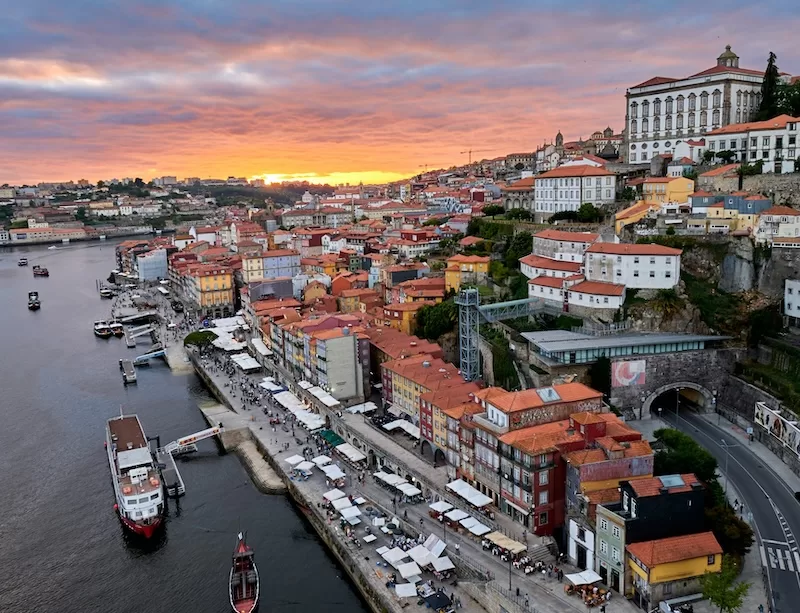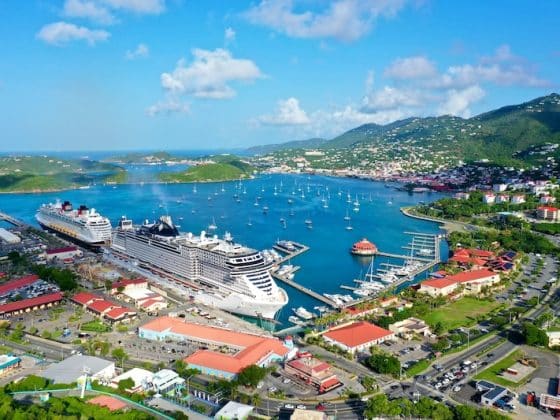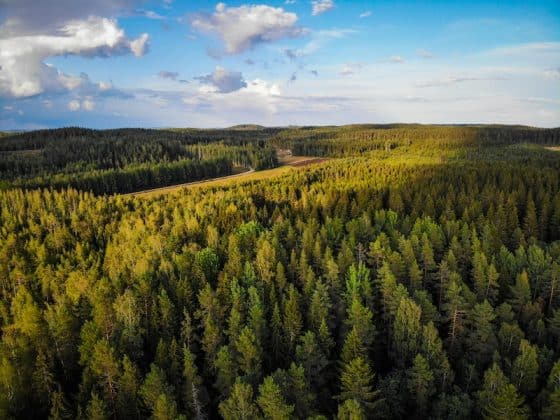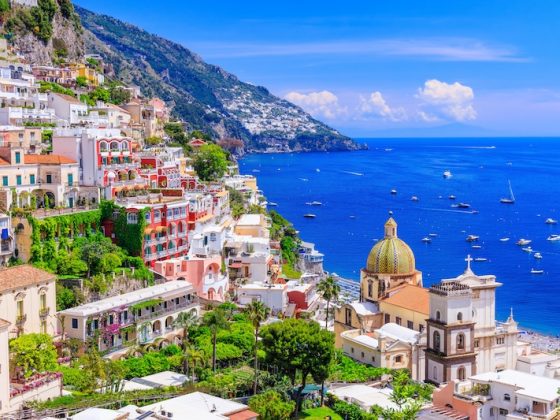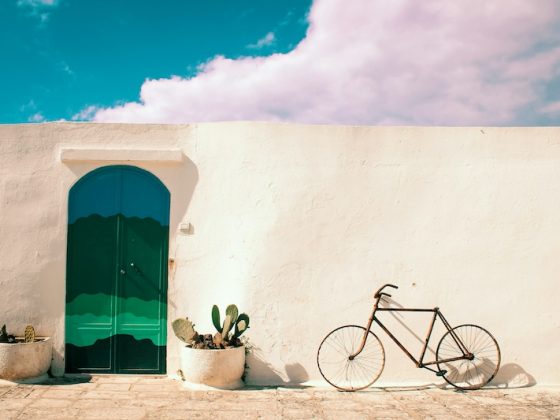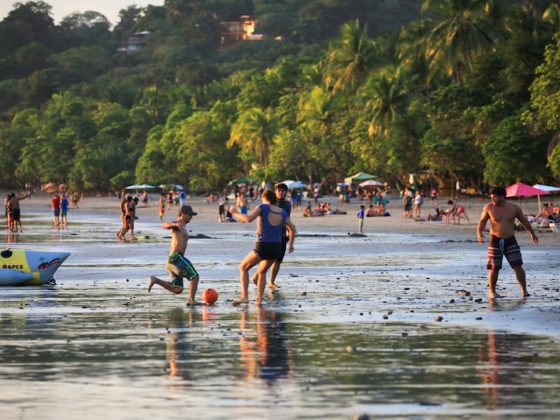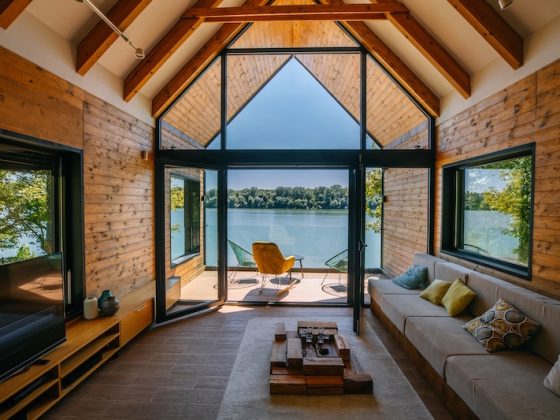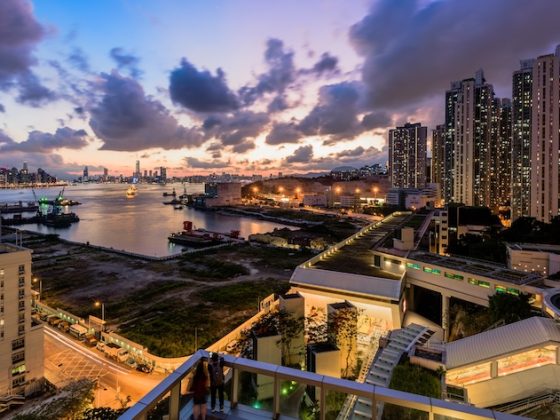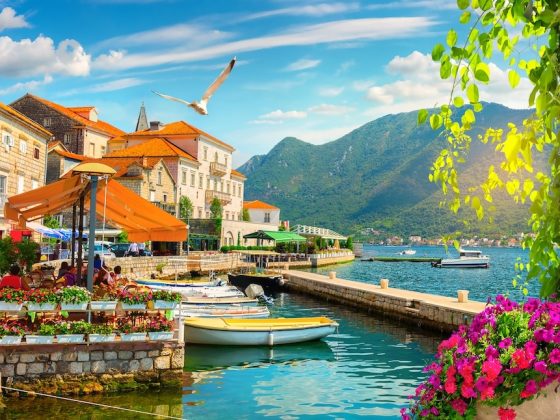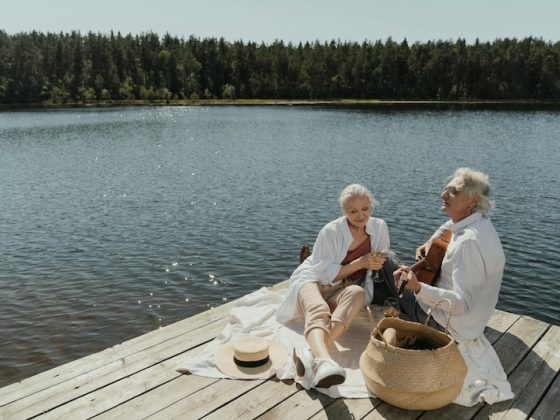Introduction
Living in Portugal as an American isn’t just a fantasy of tiled streets and seafood dinners. It’s an actual lifestyle shift that thousands of U.S. citizens are already making. From retirees to digital nomads, more Americans are calling Portugal home every year. According to SEF (now transitioning to AIMA) data, the number of U.S. residents in Portugal has grown more than 200% since 2017, a trend fueled by remote work and the search for affordable comfort.
What’s drawing people in? Sun, safety, healthcare, and a life that lets you breathe. Portugal offers the rare mix of European sophistication and everyday simplicity. This article breaks down what life here is really like (the visas, costs, small wins, and occasional frustrations), so you can make your move with both feet on the ground.
Why Portugal Appeals to Americans
Cost of Living: Quality Without the Price Tag
Simply put, Portugal remains one of Western Europe’s most affordable countries. A comfortable lifestyle here often costs 30–40% less than in major U.S. cities. Data puts monthly living expenses for A single person at typically €1,200–€1,600 outside Lisbon/Porto and €1,700–€2,300 in the big cities. Couples in Lisbon often land around €2,400–€3,200. Actuals vary by neighborhood, housing type, and season.
Lunch menus (prato do dia) with soup, a main course, wine, and coffee rarely pass €10, and a month of groceries for one person often lands around €180–€250 a month if you shop locally. Fresh fish, eggs, and seasonal produce come from nearby farms, not freight trucks.
Markets are a weekly ritual. In smaller towns, farmers pull up at dawn with vans full of oranges, tomatoes, herbs, and bread still warm from the oven. You’ll see regulars haggling good-naturedly, plastic bags swinging, and neighbors catching up over coffee afterward. The money goes straight to the grower, and the food tastes like it.
Pro Tip: Go early to the farmers’ markets (mercados municipais) or weekly feiras. Vendors often round prices in your favor if you’re polite and bring exact change. Bring small bills and a reusable bag.
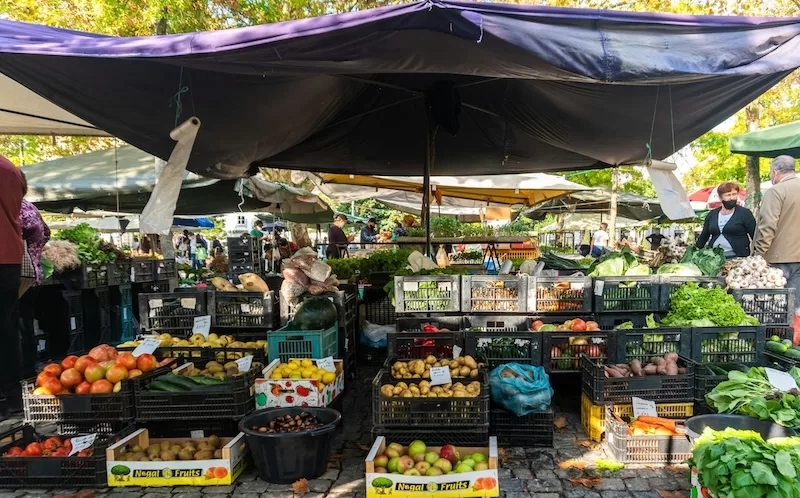
Read More Like This: Cost of Living in Portugal: What it Really Takes to Live Well
Safety and Lifestyle
Portugal consistently ranks among the world’s safest countries, having landed in the 7th place of the Global Peace Index in 2024. The Portuguese are warm, English is widely spoken in cities, and the pace of life is human-sized. It’s not unusual to see kids walking home from school alone or neighbors chatting in front of cafés at midnight.
Morning errands happen early before the heat, then everything quiets down until evening. Dinner rarely starts before eight, and weekends stretch lazily around beach walks, city strolls, picnics, or terrace coffees.
A Growing American Community
The American expat community here is thriving. There are Facebook groups for U.S. retirees in the Algarve, digital nomad meetups in Lisbon, and English bookshops in Porto that double as cultural hubs.
It’s easy to connect with other Americans, but locals will appreciate it if you make the effort to greet them in Portuguese, even if you stumble a little. A simple “Bom dia” or “Tudo bem?” goes a long way.
Healthcare That Surprises You (in a Good Way)
Americans are often shocked by how simple and inexpensive Portuguese healthcare is. Public SNS copays are usually €4–€7 for GP/urgent care and €18–€20 for ER. Private consults run €40–€60 for GPs and €60–€100 for specialists, with many mental-health visits €80–€120. Private insurance starts around €35–€70 per month for basic plans. Pharmacies act as community anchors: pharmacists often know the regulars by name and give practical advice that would require a doctor’s appointment in the U.S.
You can use the public health system (SNS) once you’re a resident, but many expats blend it with a low-cost private plan for convenience. The SNS may come with lengthy wait times, which is why having a blended system is usually a good idea.
Pro Tip: Register at your local centro de saúde early, even if you plan to use private clinics. It saves you trouble later when you need prescriptions or routine care.
Climate That Shapes Everyday Life
Portugal’s light changes everything. It’s warm and golden and makes even laundry lines look like paintings. Even winter days in Lisbon or the Algarve are often sunny enough for a walk in a T-shirt.
People live outdoors. Breakfasts spill onto terraces, evenings drift toward the beach, and weekends revolve around nature, from riverside walks in Coimbra to rooftop dinners in Porto. You’ll spend less time in cars and more time walking, which somehow makes life fuller.
In summer, locals close shutters by noon to keep homes cool, then reopen them at dusk when the air softens. By your third month, you’ll be doing the same.
Pro Tip: Houses here often have tile floors and minimal insulation. Buy slippers and a good space heater for winter: you’ll thank yourself in January.
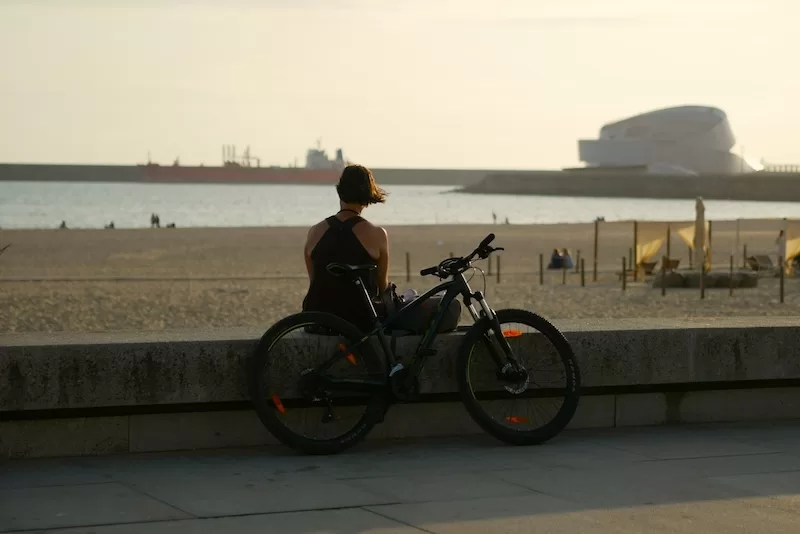
Visa and Residency Options for Americans
Moving to Portugal looks simple on paper, but the paperwork itself has layers, some clear, some confusing, and a few that change mid-application. The good news? Portugal wants expats. The bad news? You’ll need patience, copies of everything, and the ability to smile through contradictory instructions.
Here’s what actually works.
The D7 (Passive Income) Visa
The D7 visa is the classic path for retirees, remote earners, and anyone with predictable income. It’s built around the idea that you can support yourself without taking a local job. In practice, that means showing bank statements that prove at least €820 a month in income (a bit more if you’re applying with a spouse or dependents). Most successful applicants aim higher (around €1,200–€1,500 per person) to show financial stability.
You’ll start in the U.S. at your nearest Portuguese consulate. Each one has slightly different quirks: some want documents notarized, others prefer them apostilled, and all require patience. When approved, you get a four-month entry visa to come to Portugal and finish the process in person with AIMA, the immigration office.
At AIMA, you’ll hand over fingerprints, proof of address, and what feels like your entire life story. Bring multiple copies of everything: passport, NIF, lease, bank statements, even your utility bill. Portuguese bureaucracy values paper.
Pro Tip: Schedule your AIMA appointment as soon as you get your visa approval. Slots fill up months ahead, and without one, you’re stuck in limbo.
The Digital Nomad Visa
If your work comes from a laptop rather than a pension, the digital nomad visa is likely your best fit. You’ll need to prove a monthly income four times Portugal’s minimum wage (around €3,280 at the time of writing, check current figure at application time). The process is similar to the D7, but focused on employment proof instead of passive income.
Portugal has become one of Europe’s most remote-work-friendly countries. Wi-Fi is reliable, cafés double as offices, and coworking spaces from Porto to Lagos are full of international professionals who learned to balance productivity with two-hour lunches.
Boots-on-the-ground tip: When you’re setting up a local bank account (a requirement for both D7 and digital nomad visas), choose one that works well with foreign transfers. Millennium BCP, ActivoBank, and Santander are popular with Americans because they’re used to U.S. paperwork and English-speaking clients.
Golden Visa (Investment Path, Mostly Phased Out)
The famous Golden Visa (the “buy a property and get residency” route) isn’t what it used to be. Real estate-based routes were phased out in 2023 to cool speculation, but investment in cultural projects, scientific research, or job creation still qualifies. For most Americans, though, this option now makes less sense unless you’re specifically seeking a business foothold.
If your goal is simply to live here comfortably, the D7 or digital nomad routes are faster, cheaper, and better aligned with how people actually settle in.
Residency Renewal and AIMA Realities
Once you have your residence card (título de residência), it’s valid for two years, after which you’ll renew it for another three. Renewal is straightforward in theory: proof of income, address, and health insurance. In practice, it’s a dance between online forms and office appointments that sometimes get rescheduled without warning.
You’ll hear horror stories about delays. Most are true, but the system is improving. The new AIMA (Agency for Integration, Migration, and Asylum) is replacing SEF gradually, promising shorter waits and online processes. Until then, think of bureaucracy here as a patience test that everyone eventually passes.
Pro Tip: Always carry photocopies of your passport, residence card, and lease. Portuguese offices love paper trails, and having your own folder ready often saves a return trip.
What to Expect After Arrival
The real work starts as soon as you land. Here’s what most Americans do in the first few weeks:
- Get your NIF (tax number): You can apply in person at a local finanças office or hire a fiscal representative online before you arrive. It’s required for everything: renting, opening a bank account, even signing up for internet.
- Open a bank account: Some banks still ask for a Portuguese address and NIF. Bring your passport and proof of income.
- Secure housing documentation: A signed rental contract or atestado de residência (residency certificate from your local parish council) is needed for your AIMA appointment.
- Health insurance: Even basic private insurance is mandatory for your visa. Plans like Médis or Allianz are commonly accepted.
- Book your AIMA appointment: Do not wait. Slots vanish fast, and your temporary visa expires after four months.
Most of this process involves showing up in person, taking a ticket, and waiting. You’ll see people clutching folders full of documents, sipping coffee from vending machines, and trading stories in the queue. It’s frustrating, yes, but also oddly communal. Everyone’s in it together.
Practical Realities Nobody Tells You
- Appointments are sacred. Miss one and you’ll likely be pushed back months.
- Keep digital backups. Scan every document and store it in a cloud folder. You’ll be asked for the same thing twice. Sometimes three times.
- Expect inconsistencies. One office might ask for a document another doesn’t care about. Smile, comply, and bring extra copies.
- Dress decently. It shouldn’t matter, but showing up clean and polite often makes officials more helpful.
The Payoff
When you’ve cleared the paperwork maze, Portugal rewards you with stability and freedom. You can live anywhere in the country, work remotely for a U.S. employer, access healthcare, and travel across the Schengen Zone without additional visas.
It’s a long process, but it’s not impossible. The system favors those who prepare early and stay calm when things slow down. And as soon as that little residence card hits your mailbox, the frustration fades. You’ll head out for a pastel de nata and realize you’re not visiting anymore. You live here.
Where Americans Love to Live in Portugal
Lisbon: Buzz, Culture, and Connection
Lisbon is where most Americans land first. It’s busy but still relaxed, cosmopolitan yet grounded. The city stretches across seven hills that seem determined to test your calves, but the reward is constant: ocean air, tiled facades that shimmer in sunlight, and viewpoints that make you stop mid-walk just to take it in.
The capital’s popularity means higher rent (a decent one-bedroom apartment in a good neighborhood can set you back €1,300–€1,900 per month) but it also means convenience. English-speaking doctors, international schools, coworking spaces, and public transport that works, even if you have to endure crowded subways at rush hour.
Each neighborhood is like its own small town. Campo de Ourique is family-friendly and walkable, with bakeries that smell like butter at 8 a.m. Graça leans bohemian, with artists, rooftop bars, and views over the river. Alcântara mixes old warehouses with new tech offices, while across the river, Almada and Cacilhas give you ocean views and lower prices, just a short ferry ride from downtown.
Pro Tip: Forget trying to see all of Lisbon’s miradouros (viewpoints) in a week. Find one near your home and make it yours. Residents often visit the same spot every evening, glass of vinho verde in hand, watching the sky fade pink over the Tagus.
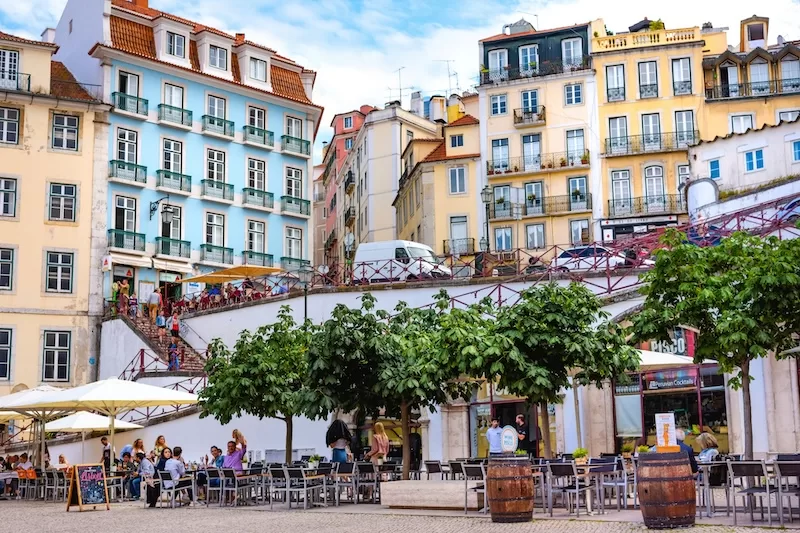
Porto: Creative, Cozy, and Northern Cool
Portugal’s second city has a grittier romance. It comes across older, moodier and colder at first, but that’s a surface impression and true warmth lies beneath. Its streets are steep; its buildings lean slightly with age. There’s less gloss than Lisbon, but more character per square meter. Rent is a bit cheaper (€900–€1,300 for a central one-bedroom), although prices have been on the rise. You’ll see more locals than tourists when you leave the riverside. The weather is cooler, the food richer (try francesinha once, survive it, and you’ll have earned local respect), and people are deeply proud of where they’re from. Stop for lunch at a tasca (a family-run eatery where house wine is often poured from unmarked bottles) and you’ll understand why Porto’s cuisine doesn’t need embellishment.
Porto’s beauty is worn, textured, and honest. Laundry hangs from tiled balconies, trams rattle along the riverfront, and the air smells like rain, espresso, and grilled sardines, especially in June, when the São João festivities take over the city. Even the sidewalks shimmer when it rains, catching the light from the streetlamps in a way that makes the whole city look cinematic. Check out the view from the top of the D. Luís Bridge or from the Gaia side of the river and you’ll be challenged to think of a more poetic viewpoint. Porto’s neighborhoods seem to gently descend the hills into the river, for a true postcard view.
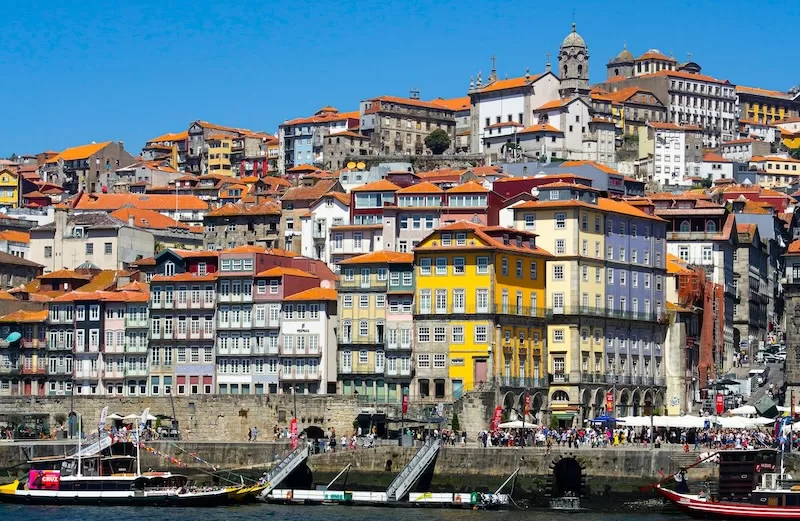
Tourism has grown, but daily life hasn’t been pushed out. Early mornings belong to delivery trucks. Students rush to classes at the University of Porto, one of the oldest in the country. Dinner might start at 9 p.m., followed by live jazz at Casa da Música or a drink by the river. The younger crowd heads to bars in the Clérigos area, Galerias de Paris and Rua Cândido dos Reis, filling them with laughter, live music, and companionship. You’ll find art galleries in Miguel Bombarda, contemporary performances at Rivoli Theatre, and weekend craft markets in several of the city’s plazas and gardens, like Mercado Porto Bello at Praça Carlos Alberto, where you can find anything from illustrations to pottery to jewelry, vintage clothing, old cameras and typewriters, vinyl records and a lot more, almost always being sold by independent creators.
The international community scene is smaller than in Lisbon, but tight knit. Most newcomers gather around coworking spaces in Cedofeita or cafes in Foz do Douro. Evenings tend to revolve around long dinners or concerts with a little bit of barhopping in between, and neighbors really say hello in stairwells.
There’s a blunt kindness in Porto that is different from the polished friendliness of the south. Ask for directions, and someone will often walk you halfway there just to make sure you don’t get lost. Strike up a conversation at a café, and it may last long enough for another round of coffee to arrive uninvited.
It’s a city that doesn’t reinvent itself to impress anyone. Instead, it invites you to take your time to discover its details: the way the light hits the tiles after rain, the sound of the trams at dusk, the smile from the same woman who sells roasted chestnuts every winter outside Bolhão.
Porto might take a little longer to love, but once it gets under your skin, it doesn’t let go.
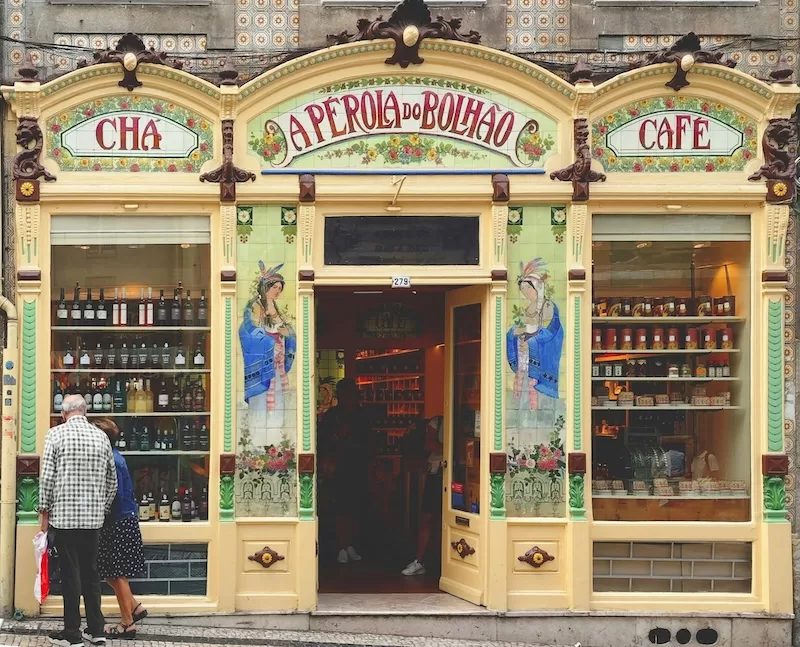
A short metro ride north of downtown lies Matosinhos, a district that is part working port, part seaside escape, and entirely devoted to food. This is where Porto comes to eat. Along Rua Heróis de França, smoke rises from rows of charcoal grills that line the street, each stacked with sardines, sea bass, or dourada sizzling over open flame. The smell alone could convert a vegetarian.
The seafood here is astonishingly fresh. Boats unload their morning catch directly to the market, and by lunchtime it’s already on your plate, seasoned with olive oil, lemon, and salt. Residents swear the best meals in Porto aren’t in Michelin-starred dining rooms but at these family-run marisqueiras, where chefs still cook by instinct and regulars linger for hours.
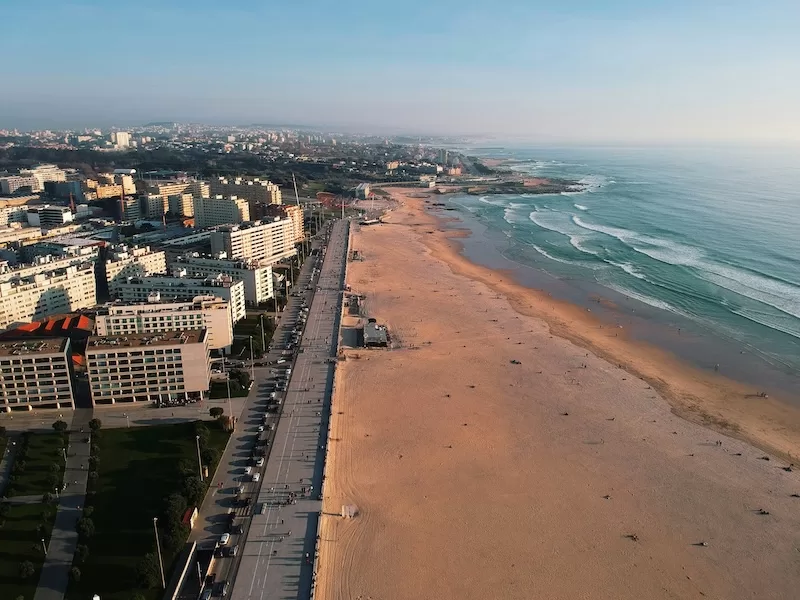
Fun Fact: Locals say Lisbon shows off to visitors, but Porto saves its charm for those who stay. They’re not wrong.
Pro tip: Cross the river Douro to Vila Nova de Gaia for a port wine tasting in one of the old cellars, then hop on the train that winds through the Douro Valley. It’s where the grapes are born and the ride feels like drifting through a painting of steep terraces and sunlight glinting off the river.
The Algarve: Sunshine Capital of Europe
If Lisbon is urban and Porto is soulful, the Algarve is pure light. It’s Portugal’s southern coastline: miles of cliffs, golden beaches, and whitewashed villages that seem too pretty to be real. Americans, Brits, and Canadians have flocked here for decades, mostly retirees and remote workers chasing warmth and space.
You’ll find strong international communities in Lagos, Tavira, Albufeira, and Vilamoura, where English is spoken almost everywhere and groceries come with friendly small talk. Rent ranges from €900 to €1,300 for a comfortable apartment, though prices jump sharply in summer when tourists flood in.
Beyond the beach clubs and golf resorts, everyday Algarve life runs on simple pleasures: grilled sardines, fruit that smells like sunshine, and evenings spent with friends on tiled patios. The region’s infrastructure is modern, hospitals are excellent, and it’s one of the safest places in Europe to drive.
Pro Tip: Visit in February. It’s calm, green, and people have time to stop and talk. You’ll get a clearer sense of what life is like when the crowds are gone.
Central Portugal: Quiet and Green
For Americans who prefer space, quiet, and authenticity, central Portugal can feel like home. Towns like Tomar, Coimbra, and Castelo Branco offer big homes for the price of a Lisbon studio, mountain air, and strong communities that still revolve around local markets and long lunches.
This is where you start to sense the rhythm of rural Portugal: slower, steadier, sometimes less convenient, but deeply human. You’ll learn that the man at the hardware store also repairs windows, that the post office sells stationery and toothpaste, and that everyone waves when you drive by.
English is less common, but locals are patient and proud to help. It’s an ideal choice if you want land, gardens, or a quieter retirement. Internet connections can be spotty in the hills, but fiber-optic coverage is spreading fast.
Coimbra sits at the heart of this region, a small city with an old soul and modern energy. Once the capital of Portugal, it carries the weight of history in its cobblestones and the pep of student life in its streets. The University of Coimbra, founded in 1290, crowns the city with baroque courtyards and echoing corridors where students still wear black capes that flutter dramatically in the wind. Every May, the city bursts into song during Queima das Fitas, a week-long celebration where graduates serenade the city with fado.
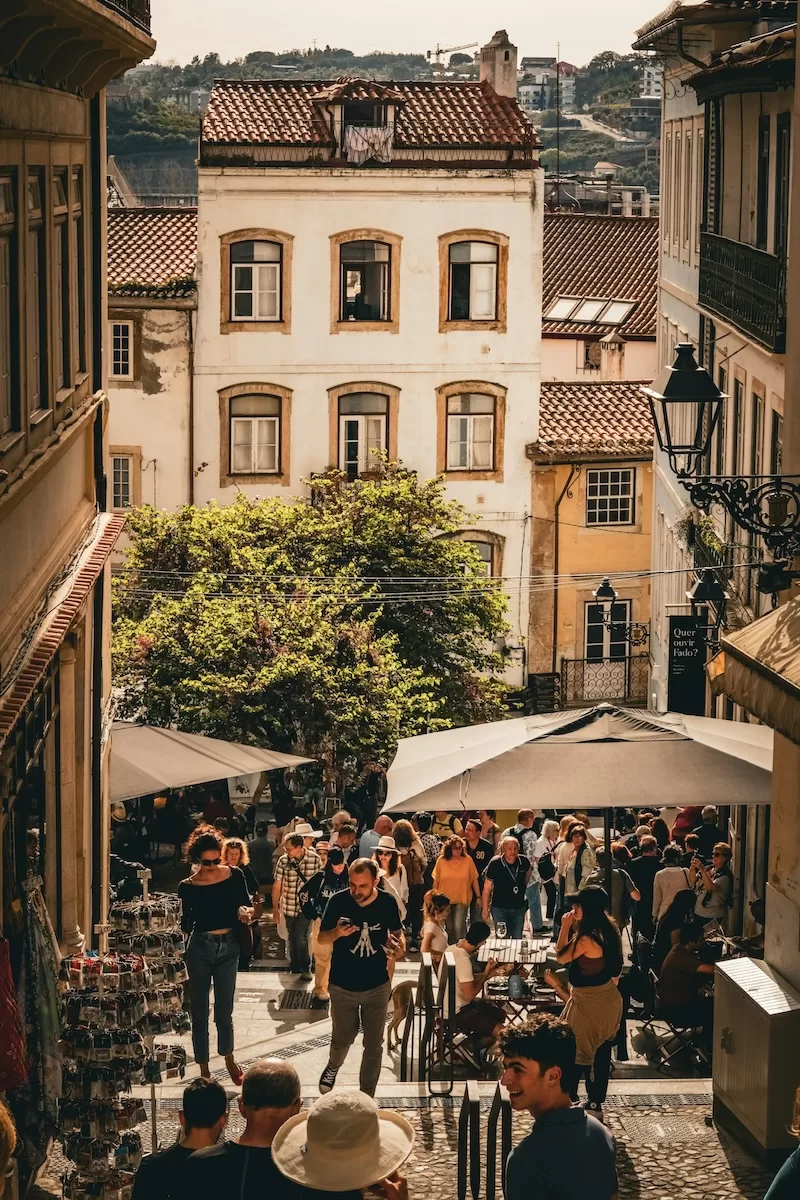
Despite its history, Coimbra isn’t stuck in the past. It’s a working, progressive city, large enough to have hospitals, shopping malls, gyms, and coworking spaces, but small enough that you can walk almost everywhere. The Mondego River splits the city in two, with leafy promenades perfect for morning jogs and cafes that spill onto the sidewalks by afternoon.
The cost of living is comfortably low by U.S. standards. You can rent a one-bedroom apartment in the center for €600–€900. Groceries are relatively cheap, and you’ll quickly find a favorite market vendor who remembers what you like.
Pro Tip: If you’re working remotely, Coimbra is a sweet spot. It’s midway between Lisbon and Porto (about 90 minutes from either) so you get easy access to the big cities without the chaos. The train station connects directly to both, making weekend trips effortless.
Fun Fact: Students in Coimbra’s university still follow a code of conduct and academic dress older than the United States itself. On certain nights, you can hear them singing traditional fado de Coimbra under the arches, a haunting sound that drifts through the streets like history whispering.
Madeira and the Azores: Island Living for the Adventurous
If you crave isolation with an ocean view, Madeira and the Azores deliver it in cinematic style. Madeira’s dramatic cliffs, forest trails, and eternal spring weather make it feel like a living postcard. The capital, Funchal, blends resort life with genuine culture: farmers’ markets, seaside promenades, and surprisingly fast internet.
The Azores are wilder, calmer, and more remote. Living there means morning mist over volcanic lakes, cows grazing under rainbows, and neighbors who will probably fix your roof before you even ask. It’s ideal for digital workers who want to unplug and nature lovers who measure time in hikes rather than hours.
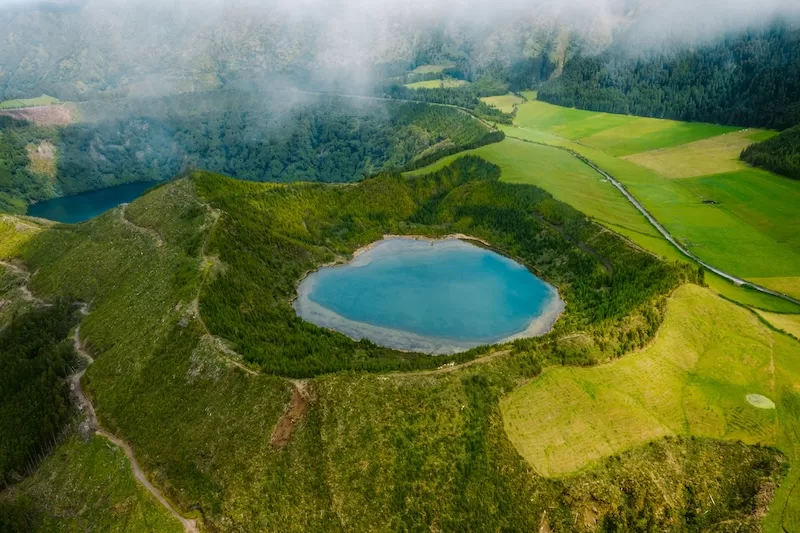
Flights to the mainland are frequent, and both island groups have small but welcoming international circles. The trade-off is availability: limited housing and fewer amenities, but unlimited peace.
Pro Tip: The weather shifts constantly. People here say you can experience four seasons in one day, and they’re not exaggerating. Bring layers and a sense of humor.
Northern Portugal: Authentic and Underrated
Head north of Porto and you enter the Portugal many tourists never see. Braga, Guimarães, and Viana do Castelo are smaller cities, affordable, and deeply Portuguese. Rents can go below €800, the food portions are heroic, and life is largely community-driven. This is where you’ll find older traditions still intact; festas that take over the whole town and people who insist you take home leftovers. The landscape is green and hilly, dotted with vineyards and stone villages that seem unchanged for centuries.
It’s not for everyone (winters are damp, and public transport is limited) but for long-term living, it’s a side of Portugal that feels endlessly genuine.
Braga is often called Portugal’s “Rome,” thanks to its abundance of churches, but that nickname misses the energy that defines it. Yes, it’s deeply Catholic (holy week processions can stop traffic) but it’s also one of the youngest cities in the country, with a large university population and a lively tech scene growing around it. The mix of sacred and modern gives Braga a fascinating texture. On one street, you’ll hear church bells; on the next, a DJ sound-checking for a rooftop event. The city is beautifully kept, with cobbled pedestrian lanes, restored baroque façades, and parks filled with families every evening. Locals are polite but direct, with a knack for making you feel welcome without fuss.
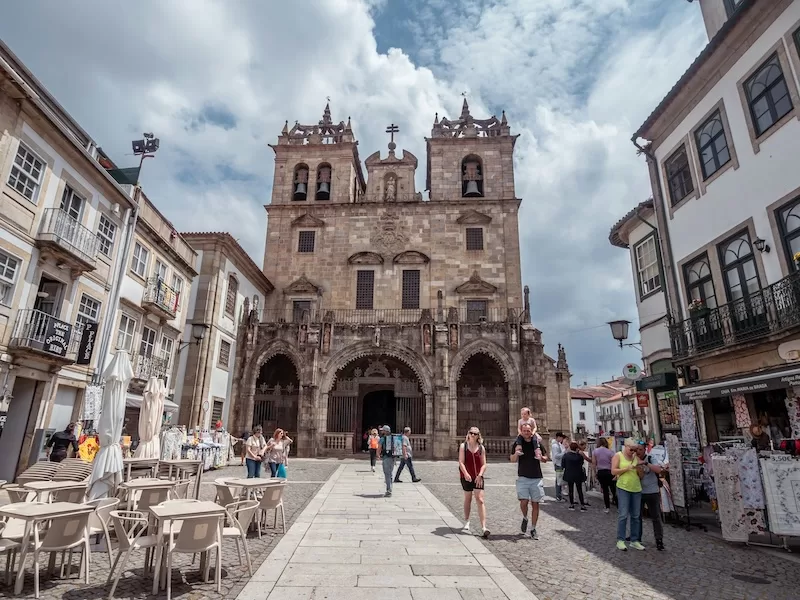
Cafés line the historic center, serving frigideiras (a meat filled pastry) and espresso strong enough to keep you talking for hours.
Pro Tip: Visit Bom Jesus do Monte, a hilltop sanctuary just outside Braga. Climb the ornate zigzagging staircase on foot at least once. It’s said to clear both lungs and conscience.
Just thirty minutes south of Braga lies Guimarães, a city that looks like a medieval painting come to life. It’s known as the cradle of the nation (Portugal’s first king was born here) but despite its UNESCO status, it’s lived-in rather than museum-like. Laundry hangs from stone windows, kids play soccer in 12th-century squares, and the smell of grilled meat floats from the tasca on the corner. Guimarães has an artistic streak that surprises newcomers. There are small galleries tucked into alleys, open-air concerts in summer, and a creative scene that blends history with experimentation. The city invests in culture: dance festivals, film festivals, design fairs, and everything in between. It’s smaller and quieter than Braga, and English is less common, but locals are famously patient. By the time you’ve been introduced, you’re treated like family, which means they’ll feed you until you protest.
Pro Tip: A lot of expats settle just outside Guimarães, in hamlets surrounded by vineyards. The houses are larger and your neighbors will bring you homemade vinho verde (young green wine) without warning.
Viana sits by the sea, where the Lima River meets the Atlantic. It’s a working port city that looks like a postcard most of the year: blue-and-white tiles, church towers, and fishing boats rocking in the harbor. Summers bring beachgoers, surfers, and one of Portugal’s most colorful festivals: Romaria da Senhora d’Agonia, when women wear gold jewelry passed down for generations and parade through the streets in traditional costume. The seafood is exceptional. You’ll find hake, octopus, and bacalhau à Vianense on every menu, usually served in portions that assume you haven’t eaten all day. Winters are damp and windy, but the smell of the ocean never fades. For many foreign residents, that trade-off (fresh air, small-town kindness, and the sound of gulls at dawn) is worth it.
How to Choose Your Portugal Base
The trick is not to pick a place based on postcards. Spend time in a few regions before committing. Portugal changes dramatically with the seasons: Lisbon blossoms in spring, the Algarve breathes in winter, and the North glows green after rain.
Short-term rentals are easy to find through platforms like Idealista or Imovirtual, or even Airbnb. Use them as a way to test-drive cities (two months in Lisbon, one in Porto, one down south) before settling.
The goal isn’t perfection; it’s fit. You’ll know it when you start recognizing the same faces at the market and when your morning coffee spot remembers your order. That’s when Portugal stops being a destination and starts feeling like home.
Read More Like This: Top 5 Places to Live in Portugal
Everyday Life and Logistics
Healthcare in Portugal
Healthcare here is one of Portugal’s strengths. Residents can access the public system (Serviço Nacional de Saúde) for a few euros per visit, or choose private coverage for faster appointments. Most expats use a mix of both. A private GP visit costs around €40–€60, and specialists usually speak English.
Pharmacies are everywhere (you’ll recognize them by their bright green crosses) and pharmacists handle minor issues on the spot, saving you a doctor’s trip. You’ll often see folks popping in to ask advice instead of booking appointments.
Pro Tip: Register early at your local centro de saúde even if you plan to go private. It gives you a health number (número de utente), which you’ll need for vaccinations, prescriptions, or emergencies.
Banking, Taxes, and the U.S. Factor
You’ll need a Portuguese tax number (NIF) before opening a bank account or signing any contract. The process is simple: show your passport and proof of address at a finanças office or through an accountant.
Bills are paid monthly, often at the multibanco (ATM) or through online banking. Keep at least one Portuguese bank account for utilities and rent: foreign cards don’t always work for local payments. Revolut accounts are starting to become more popular.
If you have a Portuguese account, you can also join MB Way, Portugal’s mobile payment system, and one of the country’s small miracles of convenience. It links directly to your bank card and lets you send or request money instantly, no fees, no paperwork. Locals use it for everything: splitting restaurant bills, paying rent, even buying vegetables at the market. Many small shops display a handwritten “MB Way accepted” sign next to the register.
Pro Tip: Millennium BCP and Novo Banco are among the most foreigner-friendly banks for Americans starting out.
Pro Tip: Download the MB Way app as soon as you open your bank account. It’s fast, secure, and far more common than credit cards for day-to-day payments. Even the pastry shop will appreciate it.
Housing and Rentals
The housing market is competitive in major cities, especially Lisbon. Expect to pay around €1,200–€1,900 monthly for a one-bedroom apartment in the center, less outside. Always sign a contract and confirm ownership before paying deposits. Outside Lisbon and Porto, you can still find comfortable homes for under €700 per month.
To rent, you’ll typically need your NIF, ID, and one or two months’ deposit. Utilities (electricity, water, gas, internet) are usually extra and can take a week or two to connect. Expect €100–€160/mo for a small apartment; winter electric can add €20–€40.
Apartments tend to be older, with beautiful tile and questionable insulation. Summers are breezy, but winters can feel colder inside than out. A good space heater and thick socks go a long way.
Groceries and Markets
Supermarkets like Pingo Doce, Continente, and Lidl carry everything you need, but the real experience is at mercados municipais. Fish counters glisten with the morning catch, different cheeses fills the stands, and the produce stands change weekly with the seasons. People buy bread daily at the bakery (usually pão de mistura or carcaças) because freshness is taken seriously.
Imported goods can be pricey, so you adapt. Peanut butter becomes a small luxury, but a kilo of oranges costs under €1. Wine, on the other hand, is cheaper than soda and usually better than expected.
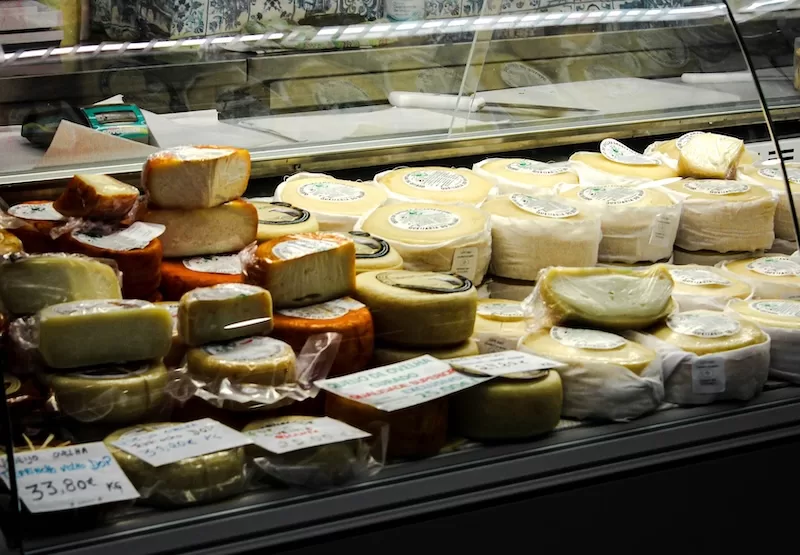
Language and Culture
English will get you through Lisbon, Porto, and the Algarve, but in smaller towns, Portuguese opens doors. Locals appreciate the effort. Even a clumsy “bom dia” earns goodwill. Generally, expats pick up conversational Portuguese within a year just by living daily life: ordering coffee, chatting with neighbors, or reading signs at shops.
Pro Tip: Download the app “Glosbe” for quick translations. It works offline and teaches context, not just vocabulary, a lifesaver when your plumber starts explaining the water heater.
Everyday Logistics
Portugal still values in-person transactions. City halls (câmaras), post offices, and immigration offices run on numbered tickets and patience. Bring copies of everything and expect to wait.
Public transport is both cheap and reliable in most urban areas, but the same cannot be said for rural areas. Trains connect the main cities, and long-distance buses reach everywhere else. Many Americans eventually buy a small car for weekend trips or rural life, but it’s not essential. It’ll depend on where you choose to pick as your home base and what kind of lifestyle you’re looking for.
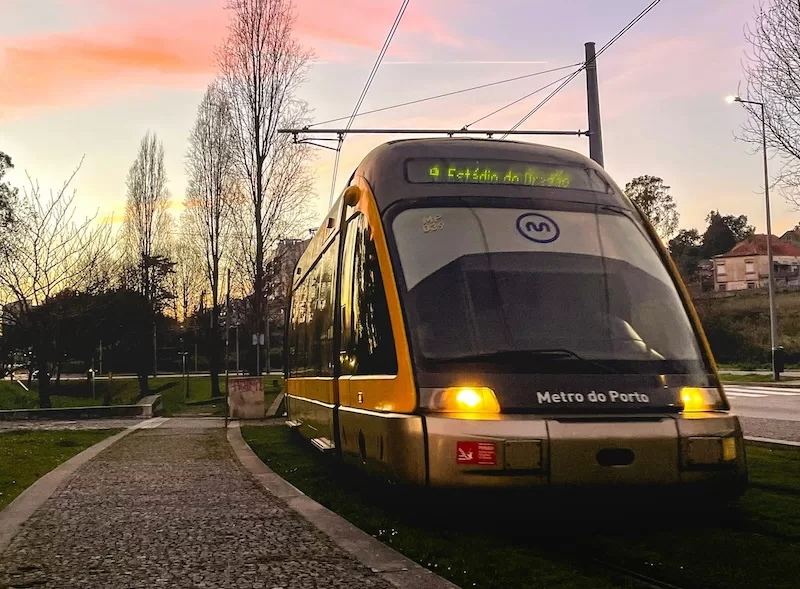
Challenges and Reality Checks
Living in Portugal as an American has its learning curve. The charm and ease people talk about are real, but so are the slow lines, the cold apartments, and the occasional feeling of “how does anyone get anything done here?” The key is to expect quirks, not problems. When you stop comparing everything to how it works back home, things start to make sense.
Bureaucracy: Slow but Predictable
Portuguese bureaucracy is, at its best, slow. Locals will be the first to tell you that. Appointments can take weeks, sometimes months, and what one official tells you may slightly differ from what another insists on. You’ll learn the golden rule early: bring more paperwork than you think you need.
At immigration offices, people arrive early with folders so thick they could double as pillows. Everyone takes a ticket, waits, chats, and eventually leaves with at least partial success. The system isn’t broken, it’s just very analog. Things get done, just not quickly.
Pro Tip: Always keep digital and paper copies of your documents. Officials often prefer printed versions, but having everything on your phone can save you in a pinch.
Urban vs. Rural
City life means convenience, but it also means higher rent. Rural Portugal offers peace, gardens, and community, but you may drive thirty minutes for groceries or deal with spotty Wi-Fi. Try renting before buying, and spend time in your chosen region during both summer and winter. Seasonal differences are real.
Housing Realities
Finding housing, especially in Lisbon or Porto, can test your patience. Apartments are smaller than what most Americans are used to, and central ones go fast. Listings on sites like Idealista can vanish within hours. In smaller towns, landlords often prefer long-term tenants over short-term stays, which works in your favor by the time you’re settled.
Insulation is minimal in most buildings, so expect chilly interiors in winter. It’s normal to see locals wearing slippers and sweaters indoors. Buy a good space heater and consider it an investment in comfort.
Climate Surprises
The weather in Portugal depends heavily on where you live. The Algarve is sunny and dry most of the year, but Porto and the north get serious rain: beautiful green hills don’t happen by accident. Central Portugal swings between hot summers and damp winters. You’ll get used to drying clothes indoors when it rains for a week straight (it also helps to buy a dehumidifier) and keeping a towel by the window during humid nights. The payoff, though, is air so clean you can smell the ocean from miles away.
One surprise for many Americans is that Portugal’s mild climate doesn’t always translate to cozy winters. Homes are built for heat, not cold, so interior temperatures drop fast when the sun disappears. Locals fight back with slippers, electric blankets, and portable heaters. As soon as spring hits, though, you’ll forget all about it. Windows open, jasmine blooms, and daily life flows back outdoors.
Taxes and Changing Rules
Tax laws here shift frequently, especially for foreign residents. The Non-Habitual Resident (NHR) program, once famous for its generous benefits, has been scaled back. You’ll still find advantages, but they depend on your income sources. Portugal and the U.S. have a double taxation treaty, which helps, but you’ll still need to file in both countries.
Most Americans hire a bilingual accountant, at least for the first year. It’s worth it. Between currency conversions, social security, and foreign income rules, you’ll save yourself hours of confusion.
Pro Tip: Keep receipts for everything, especially rent and utilities. They often qualify as deductible expenses at tax time.
Preparing for the Move
Before You Leave the U.S.
1. Start early.
Visa applications can take a few months, especially for the D7 or Digital Nomad routes. Begin gathering paperwork at least three to four months before your planned move. You’ll need proof of income, a background check (FBI), a rental agreement or invitation letter, and health insurance.
2. Apostilles and translations.
Some documents, like your background check or marriage certificate, need to be apostilled and officially translated into Portuguese. Many expats underestimate how long this takes. Get it done early.
3. Simplify your finances.
Keep your U.S. bank accounts open but notify them of your move to avoid fraud flags. If possible, choose a bank with good international features, like Charles Schwab or Wise. Both pair nicely with Portuguese banks once you arrive.
4. Health coverage.
Private insurance is required for visa approval. Stick with a plan that covers you internationally for the first few months, then switch to a local provider once you’re a resident.
5. Downsize wisely.
Most Portuguese apartments are smaller than American homes, and closets are nearly mythical. Bring essentials, leave most furniture behind, and pack universal electronics (Portugal uses 230V plugs).
Pro Tip: Bring a few passport-size photos. You’ll need them constantly: for your residence permit, transport cards, and even gym memberships.
When You Arrive
1. Get your NIF (Tax Number).
This is the key to everything: renting, opening a bank account, paying bills. You can get it in person at a Finanças office or through a fiscal representative online.
2. Open a Portuguese bank account.
You’ll need your NIF, passport, and proof of address. Millennium BCP and ActivoBank are popular choices for newcomers. Once set up, download MB Way. You’ll use it constantly, from paying rent to splitting restaurant bills.
3. Secure housing documentation.
You’ll need a signed rental contract or proof of accommodation for your AIMA (immigration) appointment. Even short-term leases help you register your address.
4. Health insurance and registration.
Keep your private plan until you’re eligible for the public healthcare system (SNS). Register at your local centro de saúde as soon as you get your residence card.
5. Mobile and internet setup.
MEO and Vodafone are the most reliable providers. You can walk into a store with your passport and NIF to get a SIM card in under 15 minutes.
6. Book your AIMA appointment early.
Appointments fill quickly, and you can’t finalize your residence card without one. Check the AIMA portal regularly for new slots: cancellations pop up daily.
Pro Tip: Bring a physical folder with copies of every document. Portuguese bureaucracy loves paper, and having your own copy often saves a trip.
In Your First Few Months
- Learn your neighborhood. Explore on foot. You’ll find small cafés, local markets, and shortcuts that maps won’t show you.
- Join expat and local groups. Facebook communities like “Americans & Friends PT” are useful for recommendations, but balance them with in-person connections.
- Set up autopay for bills. Utilities and rent can be linked through Multibanco or MB Way to avoid missed payments.
- Get familiar with holidays. Portugal loves a good day off. Government offices, banks, and even grocery stores close completely on national holidays: plan around them.
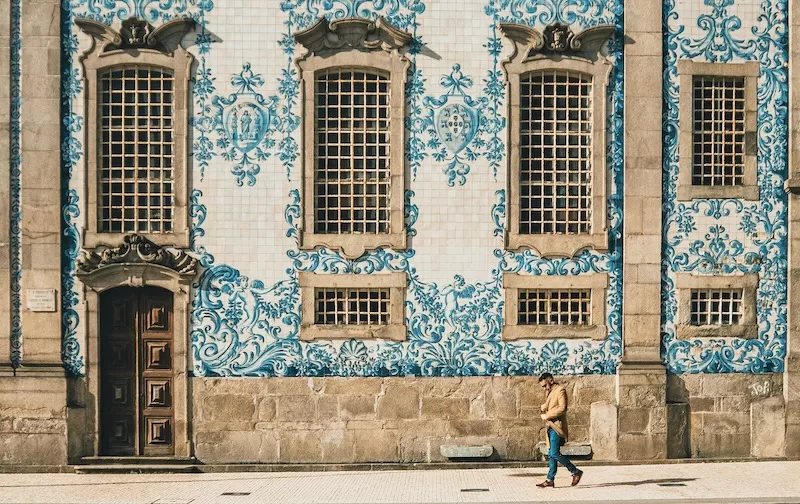
Long-Term Planning
After a few months, you’ll want to start thinking about life beyond the visa.
- Residency renewal: Your first residence card lasts two years, after which you’ll renew it for three. Keep your documents organized for renewal: income proof, lease, and insurance.
- Driving license: Americans can drive on their U.S. license for 185 days, after which you must exchange it for a Portuguese one. Some states have reciprocal agreements that make this easier. Check before moving.
- Taxes: Hire a bilingual accountant to help with U.S.-Portugal filing. It’s worth every euro.
- Community integration: Join local events, language exchanges, and volunteering groups. Portugal opens up when you engage beyond the expat bubble.
What Americans Usually Forget
- Portugal’s outlets are different (Type F plugs). A few good adapters will save your electronics.
- Clothes dryers are rare. Most people air-dry on balconies.
- Bureaucracy is slower in August. Many offices close for vacation, so avoid planning big tasks then.
- Cash still matters. Small cafés and markets sometimes prefer coins to cards, though MB Way is closing the gap fast.
- Recycling is serious business: bins are color-coded, and you’ll be judged (kindly) for mixing glass with paper.
Q1: Can Americans buy property in Portugal?
Yes. There are no restrictions on foreign ownership. You’ll need a Portuguese tax number (NIF), a local bank account, and a lawyer to review your contract. The process is transparent and secure. Most transactions go through a notary, and property taxes are modest compared to the U.S.
FAQs
Q2: How do I get a Portuguese visa as an American?
The most popular options are the D7 (Passive Income) visa and the Digital Nomad visa. Both require proof of income and health insurance. The process begins at your nearest Portuguese consulate and finishes in Portugal, where you’ll attend an appointment with AIMA.
Q3: How much money do I need to move to Portugal?
Plan for at least €10,000–€15,000 in savings to cover deposits, first months’ rent, and setup costs. For ongoing living expenses, single foreign residents typically spend €1,200–€1,600 per month outside Lisbon or Porto, €1,700–€2,300 for a single person in big cities, and €2,400–€3,2000 for a couple in a major city.
Q4: Can I work remotely for a U.S. company while living in Portugal?
Yes. That’s exactly what the Digital Nomad visa is for. You’ll pay taxes in Portugal if you spend more than 183 days per year in the country, but the U.S.-Portugal tax treaty helps prevent double taxation. Many remote workers here keep their U.S. contracts and pay local taxes.
Q5: What’s healthcare like for Americans living in Portugal?
Portugal’s public system (SNS) provides affordable care once you’re a resident. Private healthcare is also excellent, with English-speaking doctors and well-equipped facilities. Even without insurance, costs are low compared to the U.S.: an ER visit might be €20, and private insurance starts around €40 a month.
Q6: Do I need to speak Portuguese to live comfortably?
In Lisbon, Porto, and the Algarve, English will get you far. But learning Portuguese makes everything easier, from doctor visits to government offices. Locals truly appreciate the effort, and basic phrases are enough to go a long way.
Q7: How do taxes work for Americans living abroad?
You must still file a U.S. tax return annually, but the Foreign Earned Income Exclusion and the U.S.-Portugal tax treaty help avoid double taxation. You’ll also file a Portuguese return once you become a tax resident. Most expats use a bilingual accountant familiar with both systems.
Q8: Can I transfer my U.S. driver’s license?
Yes, but only within 185 days of becoming a resident. Some states (like Florida and Texas) have reciprocity agreements, which make the process smoother. If your state doesn’t, you’ll need to take a short written and driving exam.
Q9: Is Portugal a good place for retirees?
Absolutely. It’s safe, sunny, and healthcare is accessible. The D7 visa was practically designed for retirees with pensions or investment income. The Algarve and Silver Coast are especially popular, though smaller towns like Tavira, Tomar, or Évora are gaining attention for their lure and affordability.
Q10: How easy is it to bring pets from the U.S.?
Very doable. Pets need a microchip, updated rabies vaccination, and a veterinary certificate issued within 10 days of travel. Airlines flying into Lisbon or Porto are pet-friendly, and finding a vet here is easy. Many landlords accept pets, especially outside the cities.
Q11: What about safety and crime?
Portugal consistently ranks among the top five safest countries in the world. Petty theft can occur in tourist areas, but violent crime is extremely rare. You’ll feel comfortable walking at night in most neighborhoods.
Q12: What’s the internet like for remote work?
Excellent. Fiber-optic coverage reaches nearly all cities and large towns. Speeds average commonly 100–500 Mbps, with 1 Gbps plans available in major cities, and mobile service is strong even in rural areas. Coworking spaces are everywhere, from Lisbon to small surf towns like Ericeira or Sagres.
Q13: Can I vote or get citizenship eventually?
After five years of legal residency, you can apply for permanent residency or citizenship. Portugal allows dual citizenship, so you don’t have to give up your U.S. passport. You’ll need to pass a basic Portuguese language test and show a clean criminal record.
Q14: What’s everyday life like compared to the U.S.?
Simpler, slower, and less material. People cook more, walk more, and talk more. Work-life balance is taken seriously, and even bureaucrats take lunch breaks.
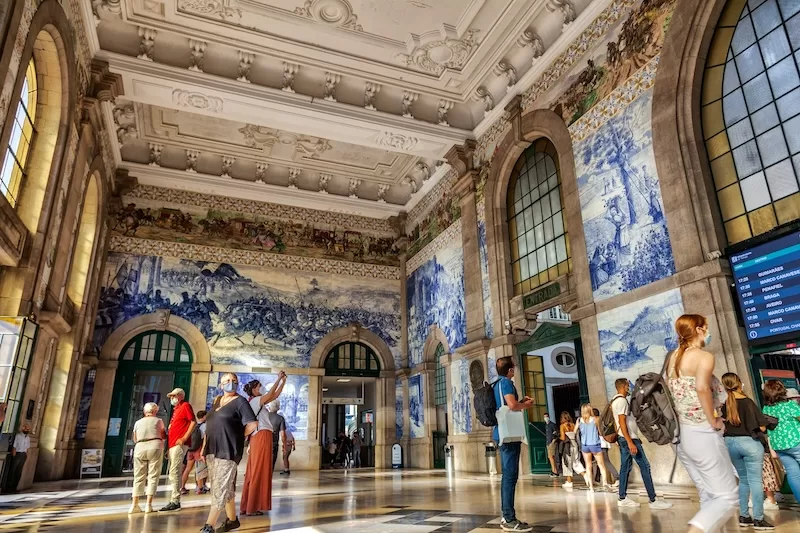
Your Next Chapter, Written in Portuguese Light
Relocating to Portugal may not be a fairytale, but it’s real life… just with better light. There will be lines, translation hiccups, and the occasional day where everything closes without warning. But there will also be mornings when the air smells like freshly baked bread, afternoons when time seems to stop, and evenings when you realize you haven’t touched your phone in hours.
Living here teaches you patience, presence, and how to savor small things, like the first sip of coffee in the square or the quiet clink of dishes from the neighbor’s balcony. It’s not about reinventing yourself, just learning to move through life a little lighter, and with more intention.
For Americans considering the move, the paperwork can be tedious, but the reward is waking up to Atlantic light, sipping espresso for a euro, and knowing your days have room for life to happen again.
Ready to start your journey? Subscribe to our newsletter for insider updates on visas, housing, and local life. Your new chapter might be waiting at the next café table with a pastel de nata and a sea breeze.
About the Author
Escape Artist’s Editorial Assistant Carla Rodrigues is a writer, editor, and creative strategist with a passion for helping ideas travel as far as people do. After building a career that spans storytelling, marketing, and international development, she joined Escape Artist to craft narratives that inform and inspire anyone ready to live beyond borders. Based in Portugal, Carla brings both creativity, precision and lived experience to her work, turning complex topics about relocation, investment, and global living into stories that feel personal, practical, and full of possibility.
Contact Author
"*" indicates required fields
Stay Ahead on Every Adventure!
Stay updated with the World News on Escape Artist. Get all the travel news, international destinations, expat living, moving abroad, Lifestyle Tips, and digital nomad opportunities. Your next journey starts here—don’t miss a moment! Subscribe Now!
